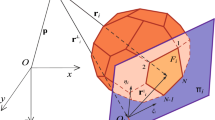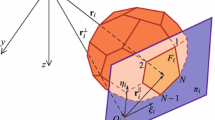Abstract
On the basis of recent analytical results we derive new formulas for computing the gravity effects of polyhedral bodies which are expressed solely as function of the coordinates of the vertices of the relevant faces. We thus prove that such formulas exhibit no singularity whenever the position of the observation point is not aligned with an edge of a face. In the opposite case, the contribution of the edge to the potential to its first-order derivative and to the diagonal entries of the second-order derivative is deemed to be zero on the basis of some claims which still require a rigorous mathematical proof. In contrast with a common statement in the literature, it is proved that only the off-diagonal entries of the second-order derivative of the potential do exhibit a noneliminable singularity when the observation point is aligned with an edge of a face. The analytical provisions on the range of validity of the derived formulas have been fully confirmed by the Matlab\(^{\textregistered }\) program which has been coded and thoroughly tested by computing the gravity effects induced by real asteroids at arbitrarily placed observation points.





Similar content being viewed by others
References
Abramowitz M, Stegun IA (eds) (1972) Handbook of mathematical functions with formulas, graphs, and mathematical tables. Dover, New York
Awange JL, Grafarend EW, Paláncz B, Zaletnyi P (2010) Algebraic geodesy and geoinformatics, 2nd edn. Springer, New York
Banerjee B, DasGupta SP (1977) Gravitational attraction of a rectangular parallelepiped. Geophysics 42:1053–1055
Barnett CT (1976) Theoretical modeling of the magnetic and gravitational fields of an arbitrarily shaped three-dimensional body. Geophysics 41:1353–1364
Bowen RM, Wang CC (2006) Introduction to vectors and tensors, Vol 2: vector and tensor analysis. http://hdl.handle.net/1969.1/3609
de Berg M, Cheong O, van Kreveld M, Overmars M (2008) Computational geometry (3rd revised ed.). Springer, Berlin
Devadoss S, O’Rourke J (2011) Discrete and computational geometry. Princeton University Press, USA
D’Urso MG, Russo P (2002) A new algorithm for point-in polygon test. Surv Rev 284:410–422
D’Urso MG (2012) New expressions of the gravitational potential and its derivates for the prism. In: Sneeuw N, Novák P, Crespi M, Sansò F (eds) VII Hotine-Marussi International Symposium on Mathematical Geodesy. Springer, Berlin
D’Urso MG (2013a) On the evaluation of the gravity effects of polyhedral bodies and a consistent treatment of related singularities. J Geod 87:239–252
D’Urso MG (2013b) A remark on the computation of the gravitational potential of masses with linearly varying density. In: Crespi M, Sansò F (eds) VIII Hotine-Marussi International Symposium. Springer, Berlin
D’Urso MG, Marmo F (2013c) Vertical stress distribution in isotropic half-spaces due to surface vertical loadings acting over polygonal domains. Zeit Ang Math Mech. doi:10.1002/zamm.201300034
D’Urso MG, Marmo F (2013d) On a generalized Love’s problem. Comp Geos 61:144–151
García-Abdeslem J (1992) Gravitational attraction of a rectangular prism with depth dependent density. Geophysics 57:470–473
García-Abdeslem J (2005) Gravitational attraction of a rectangular prism with density varying with depth following a cubic polynomial. Geophysics 70:J39–J42
Gray LJ, Glaeser JM, Kaplan T (2004) Direct evaluation of hypersingular Galerkin surface integrals. SIAM J Sci Comp 25:1534–1556
Hamayun P, Prutkin I, Tenzer R (2009) The optimum expression for the gravitational potential of polyhedral bodies having a linearly varying density distribution. J Geod 83:1163–1170
Hansen RO (1999) An analytical expression for the gravity field of a polyhedral body with linearly varying density. Geophysics 64:75–77
Heiskanen WA, Moritz H (1967) Physical Geodesy. Freeman, San Francisco
Hoffmann CM (2002) Geometric and solid modeling. http://www.cs.purdue.edu/homes/cmh/distribution/books/geo.html
Holstein H (2002) Gravimagnetic similarity in anomaly formulas for uniform polyhedra. Geophysics 67:1126–1133
Jiancheng H, Wenbin S (2010) Comparative study on two methods for calculating the gravitational potential of a prism. Geo-spat Inf Sci 13:60–64
Kellogg OD (1929) Foundations of potential theory. Springer, Berlin
Kettner L (1999) Using generic programming for designing a data structure for polyhedral surfaces. Comp Geom 13:65–90
Khayat MA, Wilton DR (2005) Numerical evaluation of singular and near-singular potential integrals. IEEE Trans Ant Prop 53:3180–3190
Klees R (1996) Numerical calculation of weakly singular surface integrals. J Geod 70:781–797
Klees R, Lehmann R (1998) Calculation of strongly singular and hypersingular surface integrals. J Geod 72:530–546
Lifanov IK, Poltavskii LN, Vainikko GM (2004) Hypersingular integral equations and their applications. CRC Press, London
MacMillan WD (1930) Theoretical mechanics, vol. 2: the theory of the potential. Mc-Graw-Hill, New York
Matlab version 7.10.0 (2012) The MathWorks Inc., Natick
Nagy D (1966) The gravitational attraction of a right rectangular prism. Geophysics 31:362–371
Nagy D, Papp G, Benedek J (2000) The gravitational potential and its derivatives for the prism. J Geod 74:553–560
Okabe M (1979) Analytical expressions for gravity anomalies due to homogeneous polyhedral bodies and translation into magnetic anomalies. Geophysics 44:730–741
Paul MK (1974) The gravity effect of a homogeneous polyhedron for three-dimensional interpretation. Pure Appl Geophys 112:553–561
Petrović S (1996) Determination of the potential of homogeneous polyhedral bodies using line integrals. J Geod 71:44–52
Pohanka V (1988) Optimum expression for computation of the gravity field of a homogeneous polyhedral body. Geophys Prospect 36:733–751
Pohanka V (1998) Optimum expression for computation of the gravity field of a polyhedral body with linearly increasing density. Geophys Prospect 46:391–404
Tang KT (2006) Mathematical methods for engineers and scientists. Springer, Berlin
Tsoulis D (2000) A note on the gravitational field of the right rectangular prism. Boll Geod Sci Aff LIX–1:21–35
Tsoulis D, Petrović S (2001) On the singularities of the gravity field of a homogeneous polyhedral body. Geophysics 66:535–539
Tsoulis D, Gonindard N, Jamet O, Verdun J (2009) Recursive algorithms for the computation of the potential harmonic coefficients of a constant density polyhedron. J Geod 83:925–942
Tsoulis D (2012) Analytical computation of the full gravity tensor of a homogeneous arbitrarily shaped polyhedral source using line integrals. Geophysics 77:F1–F11
Waldvogel J (1979) The Newtonian potential of homogeneous polyhedra. J Appl Math Phys 30:388–398
Werner RA (1994) The gravitational potential of a homogeneous polyhedron. Celest Mech Dynam Astr 59:253–278
Werner RA, Scheeres DJ (1997) Exterior gravitation of a polyhedron derived and compared with harmonic and mascon gravitation representations of asteroid 4769 Castalia. Celest Mech Dynam Astr 65:313–344
Zuber MT, Smith DE, Cheng AE, Garvin JB, Aharonson O, Cole TD, Dunn PJ, Guo Y, Lemoine FG, Neumann GA, Rowlands DD, Torrence MH (2000) The Shape of 433 Eros from the NEAR-Shoemaker Laser. Sci 289:2097–2101
Acknowledgments
The author wishes to express his deep gratitude to the Editor-in-Chief, prof. Roland Klees, to the Associate Editor, prof. Christopher Jekeli, and to the three anonymous reviewers for careful suggestions and useful comments which resulted in an improved version of the original manuscript.
Author information
Authors and Affiliations
Corresponding author
Appendices
Appendix 1
The aim of this appendix was to illustrate some useful geometrical results concerning a generic face.
In particular, we shall detail the algorithm which has been implemented to evaluate the columns of the operator \({\mathbf T}_{F_i}\) in (7) and project the observation point onto the generic face so as to determine the origin \(P_i\) of the 2D reference frame on the face, see, e.g. Fig. 2.
For a generic face, which is defined at least by three vertices, we know the coordinates of the relevant 3D vectors, say \({\mathbf r}^i_1\), \({\mathbf r}^i_2\) and \({\mathbf r}^i_3\) where, for a face with more than three vertices, the subscript 3 denotes \(N_{E_i}\); hence, we always consider as third vector the position vector of the last vertex of the face.
The unit normal to the face \(F_i\) can be evaluated as
where \(\times \) denotes the vector product and the order of vectors in it depends on the circulation sense assumed along \(Fr(F_i)\); specifically, we have assumed that the vertices of each face are numbered consecutively in a counter-clockwise sense as seen from an observer lying outside \(\varOmega \).
Denoting by
we also compute
Thus \({\mathbf v}_i\) is parallel to the face and, together with \({\mathbf u}_i\), defines the 2D reference frame on the face, see Fig. 2, as well as the operator \({\mathbf T}_{F_i}\) in (7)
Given an arbitrary vector \({\mathbf p}\), representing the observation point \(P\), our aim is to obtain the 3D coordinates of the point \({\mathbf p}_{F_i}\) representing the orthogonal projection \(P_i\) of \(P\) onto the face \(F_i\).
It is customary to choose \(P\) as the origin of the 3D reference frame in which the coordinates of the vertices of the polyhedron are assigned; hence \({\mathbf p}={\mathbf o}\). Nevertheless, for generality, we shall make reference in the sequel to an arbitrary position \({\mathbf p}\) of the observation point.
The equation of the face \(F_i\) is defined in parametric form by
or, in implicit form, as
The parametric equation of the line passing through \({\mathbf p}\) and directed along \({\mathbf n}_i\) is
Accordingly, the value \(\lambda ^*\) such that \({\mathbf r}(\lambda ^*)\in F_i\) is trivially obtained by imposing the fulfillment of (56)
from which one infers
being \({\mathbf n}_i\cdot {\mathbf n}_i=1\).
In conclusion
so that
represent the signed distance of \(P\) from the face \(F_i\).
Appendix 2
Let us consider a prism and suppose that the observation point \(P\) does belong to the interior of one of its faces. Without loss of generality we shall assume that the point belongs to the face having unit normal directed in the opposite direction with respect to the x axis, see, e.g. Fig. 6.
The position of \(P\) with respect to the face is defined by the positive quantities \(b_1\), \(b_2\), \(c_1\) and \(c_2\) so that the lengths of the edges parallel to the \(y\) and \(z\) axes are expressed by \(b= b_1+b_2\) and \(c= c_1+c_2\), respectively.
For brevity we shall detail only the computation of the integrals pertaining to the edges of the first face; for this reason we report in Fig. 7 only the relevant local reference frame.
First face of the prism in Fig. 6 and related local reference frame
Thus, the 2D position vectors of the vertices are
so that
Accordingly, one infers from (11)
for the first edge
for the second edge
for the third edge and
for the fourth edge.
Being also
one has from (39)
where
which are trivially well defined.
For the reader’s convenience we also report the final expressions of the remaining integrals.
Specifically, it turns out to be
where
for the second face;
where
for the third face;
where
for the fourth face;
where
for the fifth face;
where
for the sixth face.
The application of the previous formula to point \(P_c\) in Fig. 3 yields the numerical results reported in Table 1.
As a final remark we emphasize that the previous formulas give further account of the singularity which can characterize the off-diagonal entries of the second derivative when the observation point is aligned with one of the edges of a face.
In the example of Fig. 6 the observation point does belong to the second face so that we need to make reference to the quantities \(K_{F_2,j}, \, j=(1,\dots ,4)\) in (72).
It is apparent that whenever \(P\) in Fig. 6 tends to become aligned with one edge, i.e. one of the four quantities \(b_1\), \(b_2\), \(c_1\), \(c_2\) tends to zero, one of the four expressions in (72) becomes undefined since one of the four denominators vanishes.
Due to space limitations the analytical evaluation of the integrals \(I_{F_i}\) and \(J_{F_i}\) for the prism of Fig. 6, with constant or linearly varying density, will be reported elsewhere so as to extend the results contributed in García-Abdeslem (1992) and García-Abdeslem (2005).
Rights and permissions
About this article
Cite this article
D’Urso, M.G. Analytical computation of gravity effects for polyhedral bodies. J Geod 88, 13–29 (2014). https://doi.org/10.1007/s00190-013-0664-x
Received:
Accepted:
Published:
Issue Date:
DOI: https://doi.org/10.1007/s00190-013-0664-x






